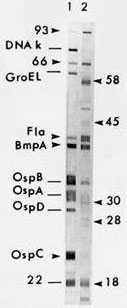Understanding the Immunoblot Test
The immunoblot is a laboratory test that looks for antibodies the body makes against different molecules, or “antigens,” that are part of the Borrelia burgdorferi bacteria. Western Blots were the first type of immunoblot developed for Lyme disease testing. Later, a striped type of immunoblot was approved by the FDA that does not require human interpretation of bands.
Practically speaking, the test produces something that looks like a bar code used on grocery items, with several lines or “bands”. Each line represents antibodies to a different component of the bacteria. As with bar codes, the presence of any one or two lines is not particularly meaningful. Instead, it is the combination of multiple, specific lines that identifies the infection as being due to Borrelia burgdorferi.

Positive Western blot.
Immunoblot tests for Lyme disease testing can detect two different classes of antibodies: IgM and IgG. IgM antibodies are made sooner, so testing for them can be helpful for identifying patients during the first few weeks of infection. The downside of testing for IgM antibodies is that they are more likely to give false positive results. Tests for IgG antibodies are more reliable, but can take 4-6 weeks for the body to produce in large enough quantities for the test to detect them.
If this sounds complex, that’s because it is. Just remember the following:
- The immunoblot should not be run without first performing an EIA or IFA.
- The immunoblot should not be run if the EIA or IFA tests are negative.
- A positive IgM immunoblot is only meaningful during the first 4 weeks of illness
- If you’ve been ill for longer than 4-6 weeks and the IgG immunoblot test is negative, it is unlikely that you have Lyme disease, even if the IgM immunoblot is positive.
Note on test result interpretation: It is not correct to interpret a test result that has only some bands that are positive as being “mildly” or “somewhat” positive for Lyme disease. The criterion that requires at least 5 IgG bands reflects the fact that people with Lyme disease have at least 5 antigens (specific molecules) detectable.
- Page last reviewed: March 4, 2015
- Page last updated: March 4, 2015
- Content source:


 ShareCompartir
ShareCompartir